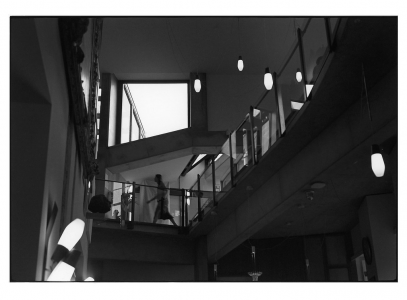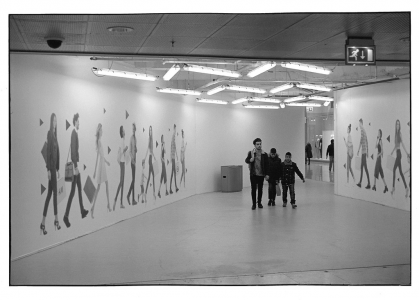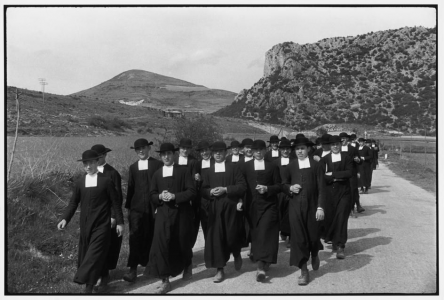Cyriljay
Leica Like
50 mm lens is equal to the best human eye perspective. If you want to eliminate more back ground you can go closer to the subject ( Walk Zoom in) or if you want to add more background walk back father to the subject( zoom out )
That is the principal ..
But remember the famous Quotes from Robert cape- " if your photos are not good you are not close enough"
That is why C-Bresson's photos were always a success. His most of the approach to environmental Humanistic photography was a close observation of them, their life style or what their reactions or the attachments to their day to day life. I think he understood the theme well before he got into his photo journey. But when you look at his very earlier photo work they are different than what he did in the middle of his career. I think he discovered something with the Range finder and there on he developed his decisive Moments in environmental Photography.
He seems to have used 35 mm but in many interview he talks about his old camera and the perspective of 50mm.
He was not particular about his photo being sharp. As many Leica photographers used Hypo-focal distance and they were the masters of photography. They mastered their tools before they got into level. CB was one of them and he never seems to bother about waiting and focusing -framing during his action on street. (there are many proofs of documentary showing that how he is shooting in streets ) That 's why his old work look like artistic photos just like painted with black and white, blurry and unsharp ,photos in a different aspect. So that old 50mm had all those heritage to create what he want.
But does someone know there's a different "luminosity' in old Leica lens to the modern Leica? That is another factor and a secret to old and new Leica lenses. One great photographer in Paris showed me and I am thankful to him for learning that.
I use my 50mm Summicron on M6 and many of my is on this lens and I am very happy with all the results. But the lens is a modern 50mm.😁
That is the principal ..
But remember the famous Quotes from Robert cape- " if your photos are not good you are not close enough"
That is why C-Bresson's photos were always a success. His most of the approach to environmental Humanistic photography was a close observation of them, their life style or what their reactions or the attachments to their day to day life. I think he understood the theme well before he got into his photo journey. But when you look at his very earlier photo work they are different than what he did in the middle of his career. I think he discovered something with the Range finder and there on he developed his decisive Moments in environmental Photography.
He seems to have used 35 mm but in many interview he talks about his old camera and the perspective of 50mm.
He was not particular about his photo being sharp. As many Leica photographers used Hypo-focal distance and they were the masters of photography. They mastered their tools before they got into level. CB was one of them and he never seems to bother about waiting and focusing -framing during his action on street. (there are many proofs of documentary showing that how he is shooting in streets ) That 's why his old work look like artistic photos just like painted with black and white, blurry and unsharp ,photos in a different aspect. So that old 50mm had all those heritage to create what he want.
But does someone know there's a different "luminosity' in old Leica lens to the modern Leica? That is another factor and a secret to old and new Leica lenses. One great photographer in Paris showed me and I am thankful to him for learning that.
I use my 50mm Summicron on M6 and many of my is on this lens and I am very happy with all the results. But the lens is a modern 50mm.😁
raid
Dad Photographer
Using my 50mm lenses does not make my images of the quality of images by HCB! This is clear 
I like using 50mm lenses. Always found the perspective to be "natural" or "normal". Contrast this with (say) the perspective of a 16mm lens. The latter can give me interesting looking images, but the perspective is not normal or natural. It is more difficult to get an interesting looking image with a 50mm lens unless you work hard on it. HCB was talented.
I like using 50mm lenses. Always found the perspective to be "natural" or "normal". Contrast this with (say) the perspective of a 16mm lens. The latter can give me interesting looking images, but the perspective is not normal or natural. It is more difficult to get an interesting looking image with a 50mm lens unless you work hard on it. HCB was talented.
Bill Clark
Mentor
Photography was a business for me, about twenty five years.
HCB came from a wealthy family so he had a different philosophy about photography than me. It’s not any better nor worse than mine.
For me, it was a way to make a living.
HCB came from a wealthy family so he had a different philosophy about photography than me. It’s not any better nor worse than mine.
For me, it was a way to make a living.
Deardorff38
Mentor
Raid, i agree....unusually wide lenses give an interesting perspective, as do long lenses with compression. IMO the 35/50/90 really rely on framing a well-composed image. Like painting or drawing.... it's the composition that ultimately captures my attention.Using my 50mm lenses does not make my images of the quality of images by HCB! This is clear
I like using 50mm lenses. Always found the perspective to be "natural" or "normal". Contrast this with (say) the perspective of a 16mm lens. The latter can give me interesting looking images, but the perspective is not normal or natural. It is more difficult to get an interesting looking image with a 50mm lens unless you work hard on it. HCB was talented.
Retro-Grouch
Well-known
Agreed. For a long time, I proceeded under the belief that there was no such thing as "too wide", though I've never been a fan of the way a tele sees. However, as I've moved more toward a documentary mode, I've realized that the more transparent my equipment is, the stronger my images. I don't want a lens or camera to impose its own way of seeing on the subject. Mostly, I now shoot with "normal" lenses, regardless of the format. "Normal" is a convention, of course, but it's one of long standing within the medium, and therefore seems least intrusive from a perspectival standpoint. I don't know that HCB felt that way, but it's a possibility.Raid, i agree....unusually wide lenses give an interesting perspective, as do long lenses with compression. IMO the 35/50/90 really rely on framing a well-composed image. Like painting or drawing.... it's the composition that ultimately captures my attention.
Keith
The best camera is one that still works!
If what they say about 50mm being nearest to the human perspective is true then I guess anything else is an effect! 😶
Last edited:
boojum
Mentor
More than the lens importance to me is what I point it at.
Erik van Straten
Mentor
Cyriljay:
"But does someone know there's a different "luminosity' in old Leica lens to the modern Leica? That is another factor and a secret to old and new Leica lenses. One great photographer in Paris showed me and I am thankful to him for learning that."The only difference in that field is the coating of the lenses. Prewar lenses are uncoated (except when they are coated after the war) so their negatives are less contrasty and as a consequence they have to be enlarged on paper with a 'harder' gradation. All other talk about 'luminosity' of the prewar lenses is bs.
Erik.
Erik van Straten
Mentor
agentlossing
Well-known
Well said. HCB has to be my favorite street photographer of all time -- I know it's a bit neophyte to say so, but I don't care. His blend of formal compositional sensibilities, the way larger scenery elements are organized, combined with the vitality of life on the street and his own subtle surrealism, always make me happy.I have just re-read most of this thread. Great dream-spinning and speculation about HCB. What is in my mind is that he was an affluent gentleman, trained in art as in painting and drawing. He was French gentility to the point of almost a stereotype with the wit and humor of the country and class. The French enjoy life and a good joke and admire quick minds. As for HCB in particular he has said it many times, he used the camera as his sketchpad. To wit, as if he were gathering images for use in a greater work later. Sketchpads are white paper and charcoal or more often a Conté crayon. So B&W was just how he would think in sketchpad terms of what he was gathering.
And he sure did not seem to be puffed up about himself. The really good can be quite humble and self-effacing even if only to deflect praise and admiration. He has left a huge impression on all who wander streets, camera in hand. He is not the only one to have done so but he surely is one of the giants. I think we are all better for knowing him.
Henry
Well-known
Unrelated, but the HCB conversation in this thread sent me down the rabbit hole with the strange tidbit that he was romantically involved with the holder of the first patent for a bra (at least in the US). I think it's interesting to see the webs that bind so much history together.
As for his work? I have no serious opinion on it. It's foundational, at this point, but that doesn't really lend itself to me having an opinion on his choices or results. Last time I went to visit Fondation Henri Cartier-Bresson they had his coronation series on display in the basement (fitting, given the timing). It's a series I'm fine with, but don't get much out of. It just doesn't click for me, and that's not the works problem, or mine, just a matter of opinion. What I liked much more was the exhibition of Vasantha Yogananthan’s in the main space on the ground floor. If you have a chance, I recommend it.
I like to see that the foundation continues to do interesting work.
As for his work? I have no serious opinion on it. It's foundational, at this point, but that doesn't really lend itself to me having an opinion on his choices or results. Last time I went to visit Fondation Henri Cartier-Bresson they had his coronation series on display in the basement (fitting, given the timing). It's a series I'm fine with, but don't get much out of. It just doesn't click for me, and that's not the works problem, or mine, just a matter of opinion. What I liked much more was the exhibition of Vasantha Yogananthan’s in the main space on the ground floor. If you have a chance, I recommend it.
I like to see that the foundation continues to do interesting work.
Erik van Straten
Mentor
Do you mean with the "coronation series" his pictures taken on the day of George VI's coronation in London in 1938? Those are great, in my opinion!Unrelated, but the HCB conversation in this thread sent me down the rabbit hole with the strange tidbit that he was romantically involved with the holder of the first patent for a bra (at least in the US). I think it's interesting to see the webs that bind so much history together.
As for his work? I have no serious opinion on it. It's foundational, at this point, but that doesn't really lend itself to me having an opinion on his choices or results. Last time I went to visit Fondation Henri Cartier-Bresson they had his coronation series on display in the basement (fitting, given the timing). It's a series I'm fine with, but don't get much out of. It just doesn't click for me, and that's not the works problem, or mine, just a matter of opinion. What I liked much more was the exhibition of Vasantha Yogananthan’s in the main space on the ground floor. If you have a chance, I recommend it.
I like to see that the foundation continues to do interesting work.
Erik.
Henry
Well-known
Yes, that's the one! Like I said, everyone has opinions on his work. I think I prefer his more casual ambling results, rather than his directed assignments.Do you mean with the "coronation series" his pictures taken on the day of George VI's coronation in London in 1938? Those are great, in my opinion!
Erik.
Erik van Straten
Mentor
He never did directed assignments. Read his biography.Yes, that's the one! Like I said, everyone has opinions on his work. I think I prefer his more casual ambling results, rather than his directed assignments.
Erik.
Henry
Well-known
I think you misunderstand what I'm saying, or I'm saying it incorrectly. He went to the UK for two pretty specific purposes: the coronation and to photograph the union actions (I can no longer remember which, but I am thinking bus workers?). I'm simply saying that I preferred his work which is more explorative and less focused. Entirely interpretive on my part, and likely not tied to anything besides internal delineations.He never did directed assignments. Read his biography.
Erik.
Erik van Straten
Mentor
telenous
Well-known
The crowning achievement of Cartier-Bresson was the work he did in Spain in 1933, published in the illustrated weekly VU magazine. You look at the photos and they just hit you, one after the other. If someone asked what's it all about, I 'd direct them to that period. That said, he always had outstanding photos to show from his travels (and at home) but they seem to pepper larger collections that included also not-so-outstanding ones. The intensity, consistency and sheer brilliance of the 1933 Spanish photographs was not repeated, I think.
Erik van Straten
Mentor
Henry
Well-known
While not religious myself, I’ve always felt like Catholicism was basically designed to be photogenic. The vestments, the structure, even their modern churches.One of the finest pictures of Cartier-Bresson is a picture he made in Spain in later years, it's a group of seminarians hiking in the mountains somewhere around Madrid.
The seminarian on the far left looks a bit like Stan Laurel.
1950's.
View attachment 4823243
agentlossing
Well-known
Definitely - the trappings of Catholicism all came about when most people were illiterate and formal education did not exist for most, and so the way churches were built, the clergy dressed, and masses were conducted were designed to convey divinity and the sacred by visual means rather than conceptually. Far more effective back then than now, perhaps, but at least we can enjoy the visual richness.While not religious myself, I’ve always felt like Catholicism was basically designed to be photogenic. The vestments, the structure, even their modern churches.
Share:
-
This site uses cookies to help personalise content, tailor your experience and to keep you logged in if you register.
By continuing to use this site, you are consenting to our use of cookies.




